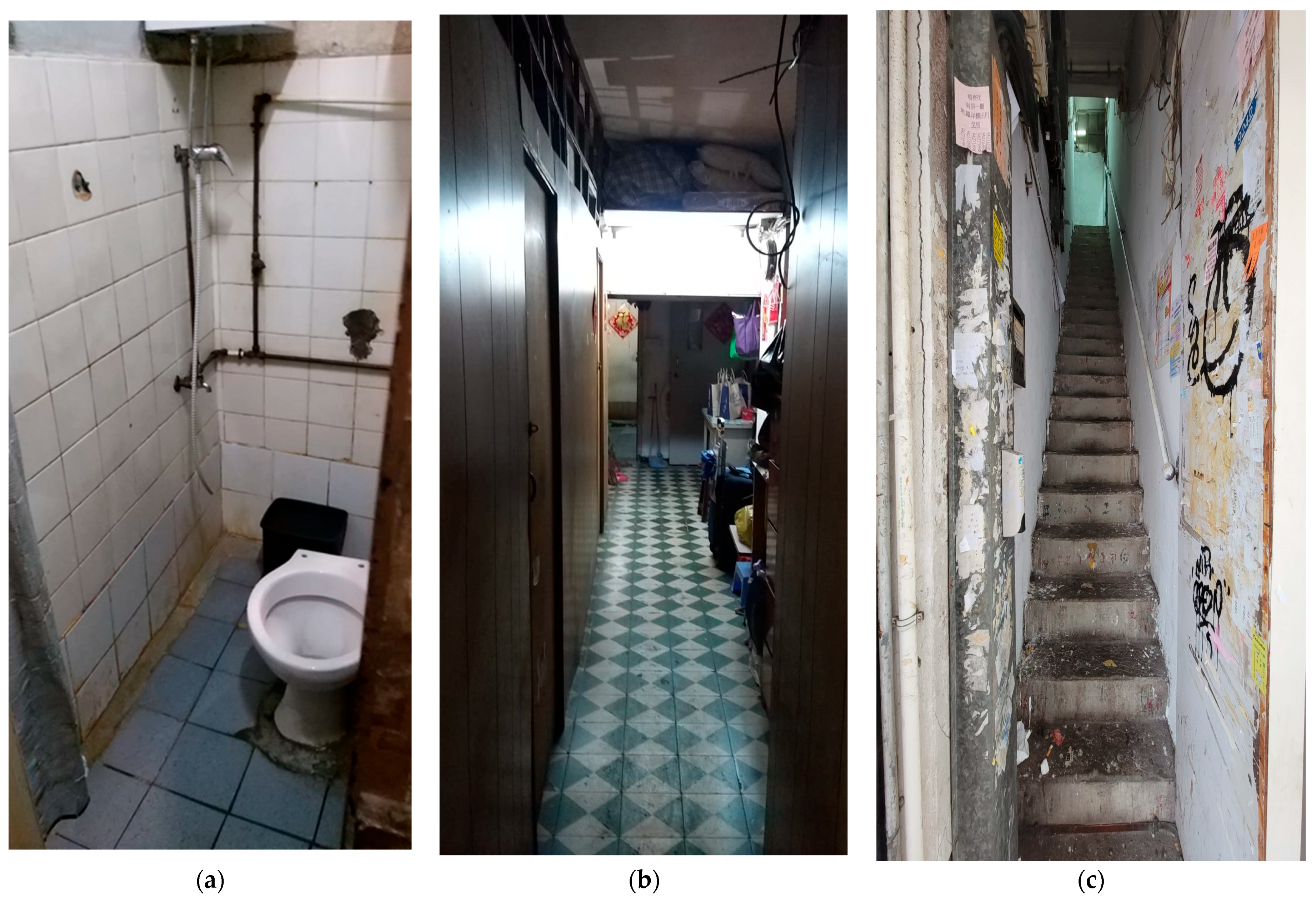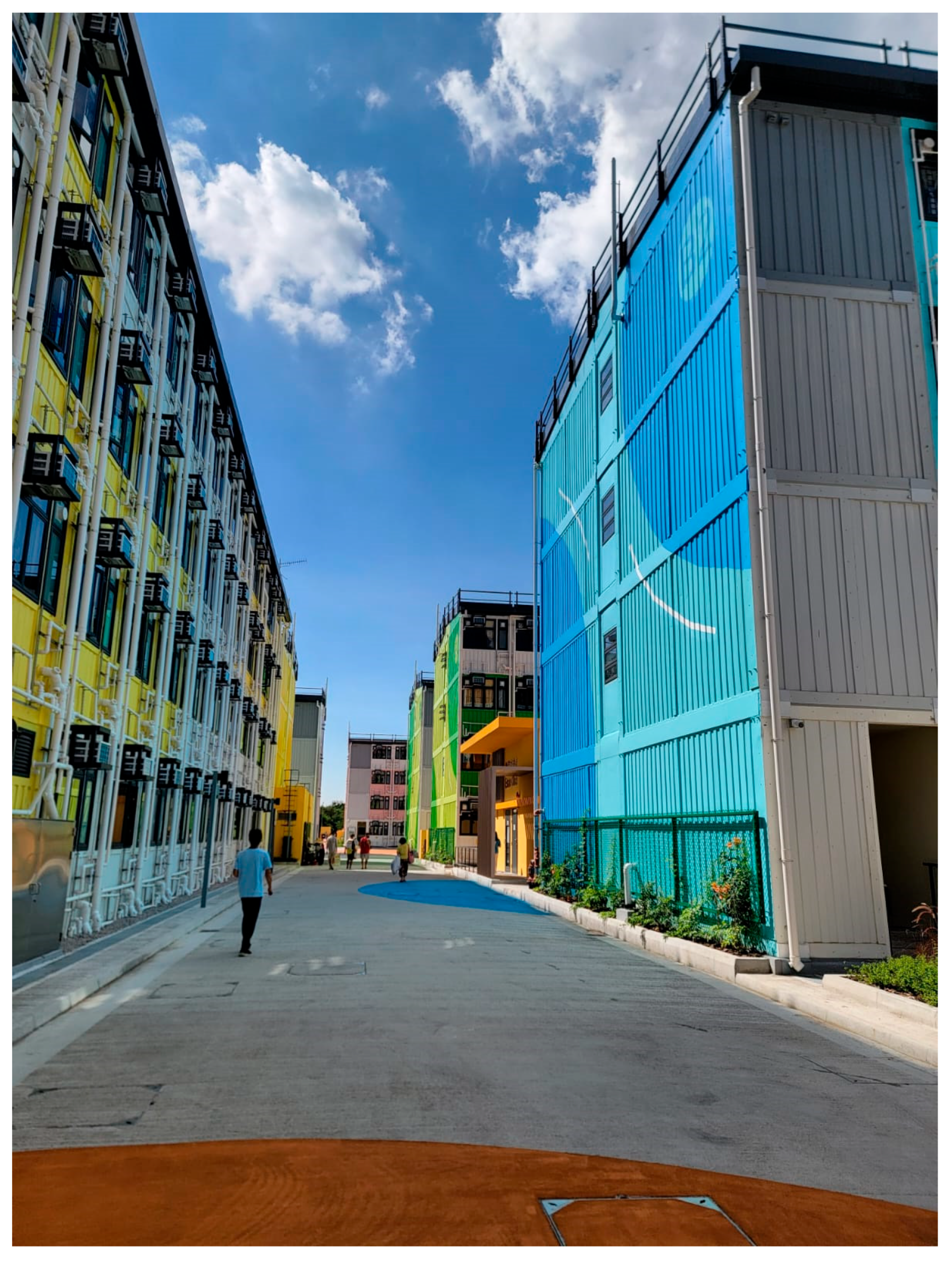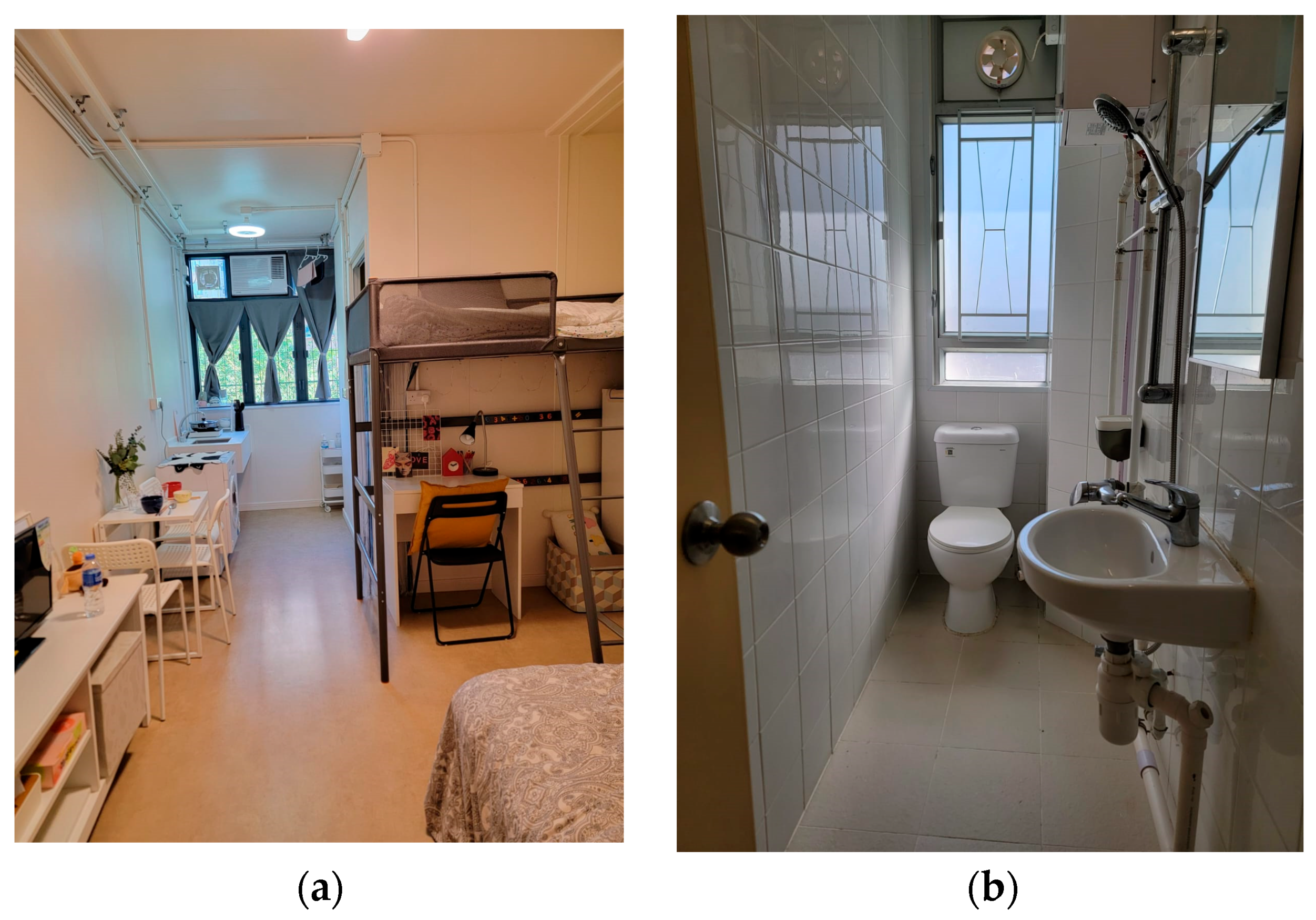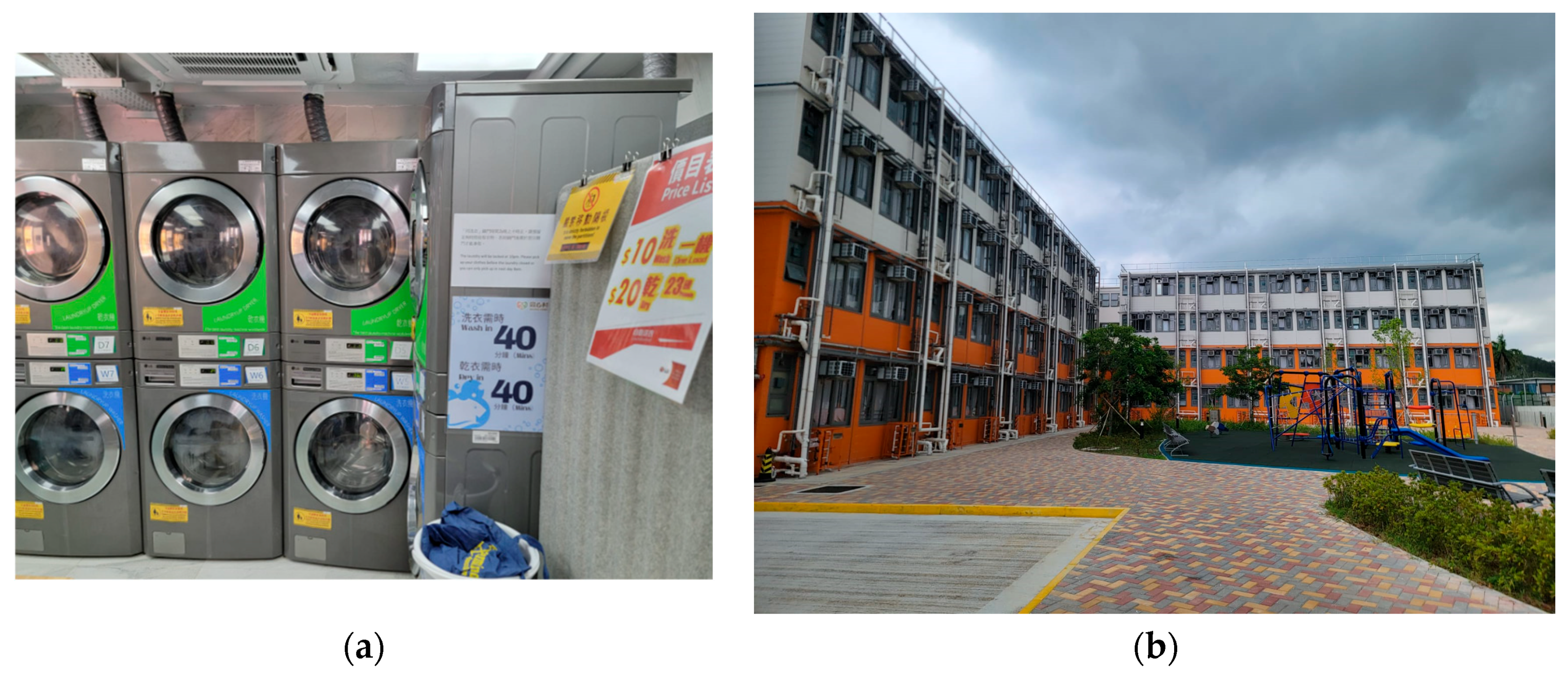Transitional Housing and the Family Capacity Building Planner: An Urban Graduation Approach for Improving the Mental Health and Well-Being of Poor Households in Hong Kong
Abstract
1. Introduction
1.1. The Relationship Between Housing, Health, and Care of Low-Income Households
1.2. The Context of Hong Kong
1.3. Housing as Infrastructure
2. Methodology
2.1. Data Collection
2.2. Research Team Positionality: Credibility and Trustworthiness
2.3. Data Analysis
3. Empirical Findings
3.1. Transitional Housing as Infrastructure for Protecting Personal Safety and Privacy
“Our flat in transitional housing programme is much safer than our previous temporary squatter. During last year’s torrential black rainstorm, our home was directly flooded, causing extensive damage to our furniture and many household items. Because of living in temporary squatter, I had to cook outdoors, which exposed us to numerous mosquito bites, leaving our legs swollen and covered in welts. Additionally, we faced threats from venomous snakes and insects. Moreover, wild boars were also a significant hazard. One day after a heavy rain, the weather cleared around 10 am. We came out and noticed a wild boar near our squatter. It was the most dangerous time in my life”.(Case 15, Female, Unmarried, 20, Senior High School)
“Overall, the improvements in privacy and sleeping conditions have made us much more comfortable, and we now enjoy greater personal freedom and privacy”.(Case 1, Male, Unmarried, 31, Undergraduate)
“Now, my son has a desk to write and read, although the overall environment is still not ideal. At least he has a small private space where he can sit down and do his own things… which was not possible before”.(Case 2, Female, Married, 50, Junior High School)
“My children and I have private space to sleep separately, which is a significant improvement. This living privacy is also more beneficial for their mental and physical developments during adolescence”.(Case 12, Female, Divorced, 40, Undergraduate)
“Our rent expenses were significantly lower after moving to there [transitional housing site]. Now I can spare a large portion of living expense to buy fruits, milk and other food supplements to improve children’s health”.(Case 7, Female, Divorced, 47, Tertiary Education)
3.2. Transitional Housing as Infrastructure for Promoting Mental and Physical Health
“[I lived in subdivided unit in last five years…] I always had to keep the lights on during the day. The three years of the pandemic made me feel very oppressed and emotionally unstable when being forced to stay in such tiny space. Owing to the living issue, family issue and other problem, I had to see a psychiatrist regularly even now I have to receive follow-up treatments every four months”.(Case 13, Female, Divorced, 53, Tertiary Education)
“After moving to my current unit [of transitional housing], which has large windows, I receive ample sunlight and improved air circulation. The room is also significantly larger than my previous one. I find my living conditions here much more comfortable, and my overall mental health has greatly improved”.(Case 13, Female, Divorced, 53, Tertiary Education)
“The environment is significantly better than before, as the bathroom is twice as large as my previous one. I prefer having a larger bed. The air quality is also improved. With the increased space, I can now arrange my daily life more freely, such as deciding when to rest and what activities to participate in. Overall, my attitude towards life has become more positive”.(Case 6, Female, Widow, 51, Senior High School Education)
“[After moving to transitional housing] I have a private bathroom and kitchen, eliminating the need to use communal, outdoor cooking and bathing facilities as I did before. The hygiene of my daily life has greatly improved, which has significantly enhanced my psychological well-being since moving in. I no longer feel as anxious and uneasy as I did previously”.(Case 15, Female, Unmarried, 20, Senior High School)
3.3. FCBP Intervention as Infrastructure for Enhancing Health and Well-Being
“Regarding our emotional and mental health issues, they offer different sorts of targeted classes and workshops. They will also follow up if we have any mental issue or concern. Therefore, living here definitely makes me feel more cheerful and at ease in daily lives”.(Case 12, Female, Divorced, 40, Undergraduate)
“I gradually developed the habit of doing exercise every day. Every day, I go jogging, stretching and practice yoga. Overall, I really enjoy nice environment there to do exercise every day and have a healthy lifestyle”.(Case 4, Male, Married, 50, Graduate)
3.4. FCBP Intervention as Infrastructure for Promoting Family Communication and Harmony
“My primary challenge has been taking care of my two children, especially since there was no one to care for them after school. Fortunately, the FCBP promptly provided after-school care services. They [FCBPs] not only take care of children but also instill a sense of responsibility and understanding toward their parents among them. For example, FCBPs encourage older children to look after the younger ones. Over time, I observed that my children began to communicate with me more frequently and developed a stronger sense of responsibility toward our household”.(Case 12, Female, Divorced, 40, Undergraduate)
“I developed anxiety due to postpartum depression and prolonged quarantine with my daughter in a confined rooftop subdivided unit during the pandemic. My mental issue led to frequent arguments with my husband over minor disagreements, sometimes escalating to the point of breakdowns, which eventually resulted in referrals to family centre social workers. After moving to transitional housing site, we now raise the importance of nurturing a harmonious environment for our family. When conflicts arise with my husband again, I walk out to public space or park near our housing site and use the knowledge I learned from workshops to calm myself down. We try to maintain a peaceful environment for my daughter, shielding her from our disputes”.(Case 5, Female, Married, 35, Undergraduate)
3.5. FCBP Intervention as Infrastructure for Coping with Poverty-Related Adversities
“At that time, I was unemployed and so depressed, so I went travelling. Then they [FCBP] knew that I had been laid off and did follow-up immediately. They comforted me and then gave me advice to restore my confidence first”.(Case 10, Female, Married, 51, Junior High School)
“I feel that they [FCBP] work together to help me find employment. For instance, if I think a job is not suitable, they will immediately follow-up, listen attentively to my feedback and provide effective advice. If I were on my own, I might feel scared or uncertain, but having more people involved gives me more confidence and useful information”.(Case 3, Female, Unmarried, 28, Senior High School)
“She [FCBP] is very attentive and patient when listening to us, and she often provides advice on various issues I encountered in daily life. Her assistance has indeed been very helpful”.(Case 12, Female, Divorced, 40, Undergraduate)
“They [FCBP] help me address issues I encounter in my daily life and work, always ready to lend a hand whenever needed”.(Case 2, Female, Married, 50, Junior High School)
3.6. FCBP Intervention as Infrastructure for the Formation of Subjectivity with Self-Efficacy and Resilience
“Due to my previous reliance on CSSA, it was difficult to save a significant amount. However, as I begin my job search and decide to achieve self-reliance, I plan to establish a stable savings plan”.(Case 3, Female, Unmarried, 28, Senior High School)
“I am currently attending classes, taking training courses to become an occupational therapy assistant. I have discovered that there is a lot to learn, and I find it very interesting. There are also other things you can do if you have motivation and plan”.(Case 10, Female, Divorced, 51, Junior High School)
“I think they [FCBPs] help many families, including mine, to have hope and confidence to uplift ourselves from the poverty regarding material and mental dimensions by our own efforts. They will be there and ready to help us”.(Case 11, Male, Married, 34, Undergraduate)
“In my career planning, my ultimate goal is both having a better career path and setting a good example for my two sons. I hope I can show them the importance of being an independent, hard-working people”.(Case 12, Female, Divorced, 40, Undergraduate)
3.7. FCBP Intervention as Infrastructure to Develop Harmonious Community Life
“They [FCBPs] have done a lot to boost the communication and mutual support among us. They really strive to construct our community like a collective. I noticed that nearly all residents take great pride in the environment. Our residents also contribute to maintaining high standards of hygiene and developing a strong sense of care and love”.Case 1, Male, Unmarried, 31, Undergraduate)
“Through participating in community activities, I have become friends with several neighbours. Sometimes, someone cooks a meal or makes soup, and we all gather to share the food. I have also cooked and made soup for others in their homes”.(Case 19, Male, Divorced, 63, Junior High School)
“After moving there [transitional housing site], we have more opportunities and places to meet different neighbours, develop connections and even friendship with them. In the past, we can do nothing but stay at home to play smartphone or watch TV. I feel like that human beings should not be isolated individuals, rather, they should thrive within a community. The atmosphere here encourages me to meet more people, engage in conversations and community activities, and ultimately enhances our well-beings in the community”.(Case 11, Male, Married, 34, Undergraduate)
4. Discussions
5. Conclusions
Author Contributions
Funding
Institutional Review Board Statement
Informed Consent Statement
Data Availability Statement
Acknowledgments
Conflicts of Interest
References
- Singh, A.; Daniel, L.; Baker, E.; Bentley, R. Housing Disadvantage and Poor Mental Health: A Systematic Review. Am. J. Prev. Med. 2019, 57, 262–272. [Google Scholar] [CrossRef] [PubMed]
- Howden-Chapman, P.; Crane, J.; Baker, M.; Viggers, H.; Chapman, R.; Cunningham, C. Health, well-being and housing. Int. Encycl. Hous. Home 2012, 2, 344–354. [Google Scholar]
- Evans, G.W.; Wells, N.M.; Moch, A. Housing and Mental Health: A Review of the Evidence and a Methodological and Conceptual Critique. J. Soc. Issues 2003, 59, 475–500. [Google Scholar] [CrossRef]
- Shaw, M. Housing and Public Health. Annu. Rev. Public Health 2004, 25, 397–418. [Google Scholar] [CrossRef]
- Braubach, M. Key Challenges of Housing and Health from WHO Perspective. Int. J. Public Health 2011, 56, 579–580. [Google Scholar] [CrossRef]
- Pollack, C.E.; Griffin, B.A.; Lynch, J. Housing Affordability and Health among Homeowners and Renters. Am. J. Prev. Med. 2010, 39, 515–521. [Google Scholar] [CrossRef]
- Morris, A. Housing tenure and the health of older Australians dependent on the age pension for their income. Hous. Stud. 2018, 33, 77–95. [Google Scholar] [CrossRef]
- Marquez, E.; Dodge Francis, C.; Gerstenberger, S. Where I Live: A Qualitative Analysis of Renters Living in Poor Housing. Health Place 2019, 58, 102143. [Google Scholar] [CrossRef]
- Lawrence, R.J. Health risks: Overcrowding. In International Encyclopedia of Housing and Home; Elsevier: Amsterdam, The Netherlands, 2012; Volume 2, pp. 339–343. [Google Scholar]
- Bonnefoy, X. Indoor air quality and health: New evidence and challenges for our changing climate. Indoor Built Environ. 2019, 28, 1–3. [Google Scholar]
- Mayne, R.; Green, D.; Guijt, I.; Walsh, M.; English, R.; Cairney, P. Using Evidence to Influence Policy: Oxfam’s Experience. Palgrave Commun. 2018, 4, 122. [Google Scholar] [CrossRef]
- Clair, A.; Hughes, A. Housing and Health: New Evidence Using Biomarker Data. J. Epidemiol. Community Health 2019, 73, 256–262. [Google Scholar] [CrossRef] [PubMed]
- Marsh, A.; Gordon, D.; Heslop, P.; Pantazis, C. Housing Deprivation and Health: A Longitudinal Analysis. Hous. Stud. 2000, 15, 411–428. [Google Scholar] [CrossRef]
- Piat, M.; Polvere, L.; Kirst, M.; Voronka, J.; Zabkiewicz, D.; Plante, M.-C.; Isaak, C.; Nolin, D.; Nelson, G.; Goering, P. Pathways into Homelessness: Understanding How Both Individual and Structural Factors Contribute to and Sustain Homelessness in Canada. Urban Stud. 2015, 52, 2366–2382. [Google Scholar] [CrossRef]
- Izuhara, M. Life-Course Diversity, Housing Choices and Constraints for Women of the ‘Lost’ Generation in Japan. Hous. Stud. 2015, 30, 60–77. [Google Scholar] [CrossRef]
- Baker, E.; Mason, K.; Bentley, R.; Mallett, S. Exploring the Bi-Directional Relationship between Health and Housing in Australia. Urban Policy Res. 2014, 32, 71–84. [Google Scholar] [CrossRef]
- Durbin, A.; Nisenbaum, R.; Kopp, B.; O’Campo, P.; Hwang, S.W.; Stergiopoulos, V. Are Resilience and Perceived Stress Related to Social Support and Housing Stability among Homeless Adults with Mental Illness? Health Soc. Care Community 2019, 27, 1053–1062. [Google Scholar] [CrossRef]
- Rautio, N.; Filatova, S.; Lehtiniemi, H.; Miettunen, J. Living Environment and Its Relationship to Depressive Mood: A Systematic Review. Int. J. Soc. Psychiatry 2018, 64, 92–103. [Google Scholar] [CrossRef]
- Tam, M.W.Y.; Hui, E.; Zheng, X. Residential mortgage default behaviour in Hong Kong. Hous. Stud. 2010, 25, 647–669. [Google Scholar] [CrossRef]
- Doling, J.; Ronald, R. Home Ownership and Asset-Based Welfare. J. Hous. Built Environ. 2010, 25, 165–173. [Google Scholar] [CrossRef]
- Dean, M.M. Governmentality: Power and Rule in Modern Society; SAGE Publications: Thousand Oaks, CA, USA, 2009. [Google Scholar]
- Power, E.R. Housing, Home Ownership and the Governance of Ageing. Geogr. J. 2017, 183, 233–246. [Google Scholar] [CrossRef]
- Wong, C.S.M.; Chan, W.C.; Chu, N.W.T.; Law, W.Y.; Tang, H.W.Y.; Wong, T.Y.; Chen, E.Y.H.; Lam, L.C.W. Individual and Interactive Effects of Housing and Neighborhood Quality on Mental Health in Hong Kong: A Retrospective Cohort Study. J. Urban Health 2024, 101, 804–814. [Google Scholar] [CrossRef] [PubMed]
- Yau, Y.; Yip, K.C. No More Illegal Subdivided Units? A Game-Theoretical Explanation of the Failure of Building Control in Hong Kong. Buildings 2022, 12, 1005. [Google Scholar] [CrossRef]
- Chan, S.M. Unhealthy Housing Experiences of Subdivided Unit Tenants in the World’s Most Unaffordable City. J. Hous. Built Environ. 2023, 38, 2229–2246. [Google Scholar] [CrossRef]
- Fung, E.H.C.; Chiu, S.W.; Lam, H.-M.; Chung, R.Y.-N.; Wong, S.Y.S.; Chan, S.M.; Dong, D.; Wong, H. The Impact of Bedbug (Cimex Spp.) Bites on Self-Rated Health and Average Hours of Sleep per Day: A Cross-Sectional Study among Hong Kong Bedbug Victims. Insects 2021, 12, 1027. [Google Scholar] [CrossRef]
- Fung, E.H.C.; Wong, H.; Chiu, S.W.; Hui, J.H.L.; Lam, H.M.; Chung, R.Y.; Wong, S.Y.; Chan, S.M. Risk Factors Associated with Bedbug (Cimex spp.) Infestations among Hong Kong Households: A Cross-Sectional Study. J. Hous. Built Environ. 2022, 37, 1411–1429. [Google Scholar] [CrossRef]
- Chung, K.-T.W. The Issue of Subdivided Units in Hong Kong: Licensing as a Solution? Ph.D. Thesis, City University of Hong Kong, Hong Kong, China, 2014. [Google Scholar]
- Chan, S.-M.; Wu, Y.; Chen, A.; Tang, Y.-K.; Au-Yeung, T.-C.; Tam, N.W.-Y. The Impact of Tenancy Control on Housing Precarity in Hong Kong: A Panel Study of Subdivided Unit Residents. Cities 2025, 158, 105693. [Google Scholar] [CrossRef]
- Legislative Council of the Hong Kong Special Administrative Region—Meeting Papers. Available online: https://www.legco.gov.hk/en/legco-business/committees/meeting-papers.html?panels=housing&2024&20240603 (accessed on 14 May 2025).
- Housing Bureau—Policy—Housing—Transitional Housing—Transitional Housing Projects. Available online: https://www.hb.gov.hk/eng/policy/housing/policy/transitionalhousing/transitionalhousing.html (accessed on 14 May 2025).
- Chan, S.-M.; Wong, H.; Au-Yeung, T.-C.; Li, S.-N. Impact of Multi-Dimensional Precarity on Rough Sleeping: Evidence from Hong Kong. Habitat. Int. 2023, 136, 102831. [Google Scholar] [CrossRef]
- Banerjee, A.; Duflo, E.; Sharma, G. Long-Term Effects of the Targeting the Ultra Poor Program. Am. Econ. Rev. Insights 2021, 3, 471–486. [Google Scholar] [CrossRef]
- Rahman, A.; Bhattacharjee, A.; Nisat, R.; Das, N. Graduation Approach to Poverty Reduction in the Humanitarian Context: Evidence from Bangladesh. J. Int. Dev. 2023, 35, 1287–1317. [Google Scholar] [CrossRef]
- Power, E.R.; Wiesel, I.; Mitchell, E.; Mee, K.J. Shadow Care Infrastructures: Sustaining Life in Post-Welfare Cities. Prog. Hum. Geogr. 2022, 46, 1165–1184. [Google Scholar] [CrossRef]
- Power, E.R.; Mee, K.J. Housing: An Infrastructure of Care. Hous. Stud. 2020, 35, 484–505. [Google Scholar] [CrossRef]
- Bergan, T.L.; Power, E.R. Conceptualising Housing as Infrastructure: A Framework for Thinking Infrastructurally in Housing Studies. Hous. Stud. 2025, 40, 673–695. [Google Scholar] [CrossRef]
- Flanagan, K.; Martin, C.; Jacobs, K.; Lawson, J. A Conceptual Analysis of Social Housing as Infrastructure; Australian Housing and Urban Research Institute Limited: Melbourne, Australia, 2019. [Google Scholar]
- Lawson, J.; Troy, L.; van den Nouwelant, R. Social Housing as Infrastructure and the Role of Mission Driven Financing. Hous. Stud. 2024, 39, 398–418. [Google Scholar] [CrossRef]
- Amin, A. Lively Infrastructure. Theory Cult. Soc. 2014, 31, 137–161. [Google Scholar] [CrossRef]
- Larkin, B. The politics and poetics of infrastructure. Annu. Rev. Anthropol. 2013, 42, 327–343. [Google Scholar] [CrossRef]
- Boyer, D. Infrastructure, Potential Energy, Revolution. In The Promise of Infrastructure; Anand, N., Gupta, A., Appel, H., Eds.; Duke University Press: Durham, NC, USA, 2018; pp. 223–244. ISBN 978-1-4780-0203-1. [Google Scholar]
- Larkin, B. Promising forms: The political aesthetics of infrastructure. In The Promise of Infrastructure; Anand, N., Gupta, A., Appel, H., Eds.; Duke University Press: Durham, NC, USA, 2018; pp. 175–202. [Google Scholar]
- Appel, H.; Anand, N.; Gupta, A. Introduction: Temporality, Politics, and the Promise of Infrastructure. In The Promise of Infrastructure; Anand, N., Gupta, A., Appel, H., Eds.; Duke University Press: Durham, NC, USA, 2018; pp. 1–38. ISBN 978-1-4780-0203-1. [Google Scholar]
- Fennell, C. Last Project Standing: Civics and Sympathy in Post-Welfare Chicago; University of Minnesota Press: Minneapolis, MN, USA, 2015. [Google Scholar]
- Amankwaa, L. Creating Protocols for Trustworthiness in Qualitative Research. J. Cult. Divers. 2016, 23, 121–127. [Google Scholar]
- Braun, V.; Clarke, V. Using Thematic Analysis in Psychology. Qual. Res. Psychol. 2006, 3, 77–101. [Google Scholar] [CrossRef]




| Participant | Sex/Age Range | Education | Previous Housing Type | No. of Family Members | Income Source | Area of Previous Housing (ft2) | Rent of Previous Housing (HKD) | Area of Current Housing (ft2) | Rent of Current Housing (HKD) |
|---|---|---|---|---|---|---|---|---|---|
| 1 | M/30–34 | University or above | Public rental housing | 1 | Working | 300 | NA | 100 | 2000 |
| 2 | F/50–54 | Junior high school | Public rental housing | 4 | Working | 300 | NA | 200 | 3800 |
| 3 | F/25–29 | high school | Suite | 1 | Comprehensive Social Security Assistance (CSSA) | 200 | 4000 | 250 | 2600 |
| 4 | M/50–54 | University or above | Subdivided unit | 3 | Comprehensive Social Security Assistance (CSSA) | 100 | 3000 | 180 | 4900 |
| 5 | F/35–39 | University or above | Rooftop dwellers | 3 | Comprehensive Social Security Assistance (CSSA) | 100 | 7000 | 180 | 4900 |
| 6 | F/50–54 | high school | Public rental housing | 1 | Working | 300 | 680 | 165 | 2400 |
| 7 | F/45–49 | College | Rent private housing (whole) | 3 | Working | 100 | 10,000 | 168 | 2600 |
| 8 | F/60–64 | College | Factory building | 1 | Working | 100 | 5000 | 168 | 2400 |
| 9 | F/50–54 | Junior high school | Rent private housing (whole) | 2 | Savings | 200 | NA | 168 | 2400 |
| 10 | F/50–54 | University or above | Subdivided unit | 1 | Working, Comprehensive Social Security Assistance (CSSA) | 80 | 2515 | 150 | 4000 |
| 11 | M/30–34 | University or above | Subdivided unit | 3 | Working | 160 | 6400 | 200 | 3000 |
| 12 | F/40–44 | University or above | Village house | 3 | Working | 180 | 4900 | 168 | 4600 |
| 13 | F/50–54 | College | Subdivided unit | 3 | Working | 100 | 4900 | 180 | 3700 |
| 14 | F/45–49 | high school | Dormitory house | 1 | Working, Comprehensive Social Security Assistance (CSSA) | 100 | NA | 170 | 2400 |
| 15 | F/20–24 | high school | Squatter | 1 | Comprehensive Social Security Assistance (CSSA) | 100 | 2000 | 160 | 2515 |
| 16 | F/50–54 | NA | Village house | 1 | Working | NA | NA | NA | NA |
| 17 | F/45–49 | College | Village house | 2 | Working | 100 | 4000 | 170 | 2400 |
| 18 | F/35–39 | Junior high school | Village house | 2 | Comprehensive Social Security Assistance (CSSA) | 350 | 7000 | 160 | 4440 |
| 19 | M/60–64 | Junior high school | Dormitory house | 1 | Working, Comprehensive Social Security Assistance (CSSA) | 100 | 1780 | 170 | 2400 |
| 20 | F/55–59 | high school | Rooftop dwellers | 1 | Working | 300 | 3400 | 170 | 2400 |
| 21 | M/60–64 | primary school | Bedspace | 1 | Comprehensive Social Security Assistance (CSSA) | 100 | 4200 | 172 | 2200 |
| 22 | F/30–34 | high school | Dormitory house | 1 | Working, Comprehensive Social Security Assistance (CSSA) | 170 | 3100 | 170 | 2500 |
| 23 | F/54–59 | primary school | Subdivided unit | 1 | Comprehensive Social Security Assistance (CSSA), Saving | 50 | 4000 | 160 | 2400 |
| 24 | F/30–34 | high school | Village house | 4 | Working | 400 | 6000 | 500 | 5000 |
Disclaimer/Publisher’s Note: The statements, opinions and data contained in all publications are solely those of the individual author(s) and contributor(s) and not of MDPI and/or the editor(s). MDPI and/or the editor(s) disclaim responsibility for any injury to people or property resulting from any ideas, methods, instructions or products referred to in the content. |
© 2025 by the authors. Licensee MDPI, Basel, Switzerland. This article is an open access article distributed under the terms and conditions of the Creative Commons Attribution (CC BY) license (https://creativecommons.org/licenses/by/4.0/).
Share and Cite
Chan, S.-M.; Xu, H.; Tang, Y.-K.; Kwok, K.; Leung, K.-M. Transitional Housing and the Family Capacity Building Planner: An Urban Graduation Approach for Improving the Mental Health and Well-Being of Poor Households in Hong Kong. Buildings 2025, 15, 1973. https://doi.org/10.3390/buildings15121973
Chan S-M, Xu H, Tang Y-K, Kwok K, Leung K-M. Transitional Housing and the Family Capacity Building Planner: An Urban Graduation Approach for Improving the Mental Health and Well-Being of Poor Households in Hong Kong. Buildings. 2025; 15(12):1973. https://doi.org/10.3390/buildings15121973
Chicago/Turabian StyleChan, Siu-Ming, Heng Xu, Yuen-Ki Tang, Kim Kwok, and Ka-Man Leung. 2025. "Transitional Housing and the Family Capacity Building Planner: An Urban Graduation Approach for Improving the Mental Health and Well-Being of Poor Households in Hong Kong" Buildings 15, no. 12: 1973. https://doi.org/10.3390/buildings15121973
APA StyleChan, S.-M., Xu, H., Tang, Y.-K., Kwok, K., & Leung, K.-M. (2025). Transitional Housing and the Family Capacity Building Planner: An Urban Graduation Approach for Improving the Mental Health and Well-Being of Poor Households in Hong Kong. Buildings, 15(12), 1973. https://doi.org/10.3390/buildings15121973






